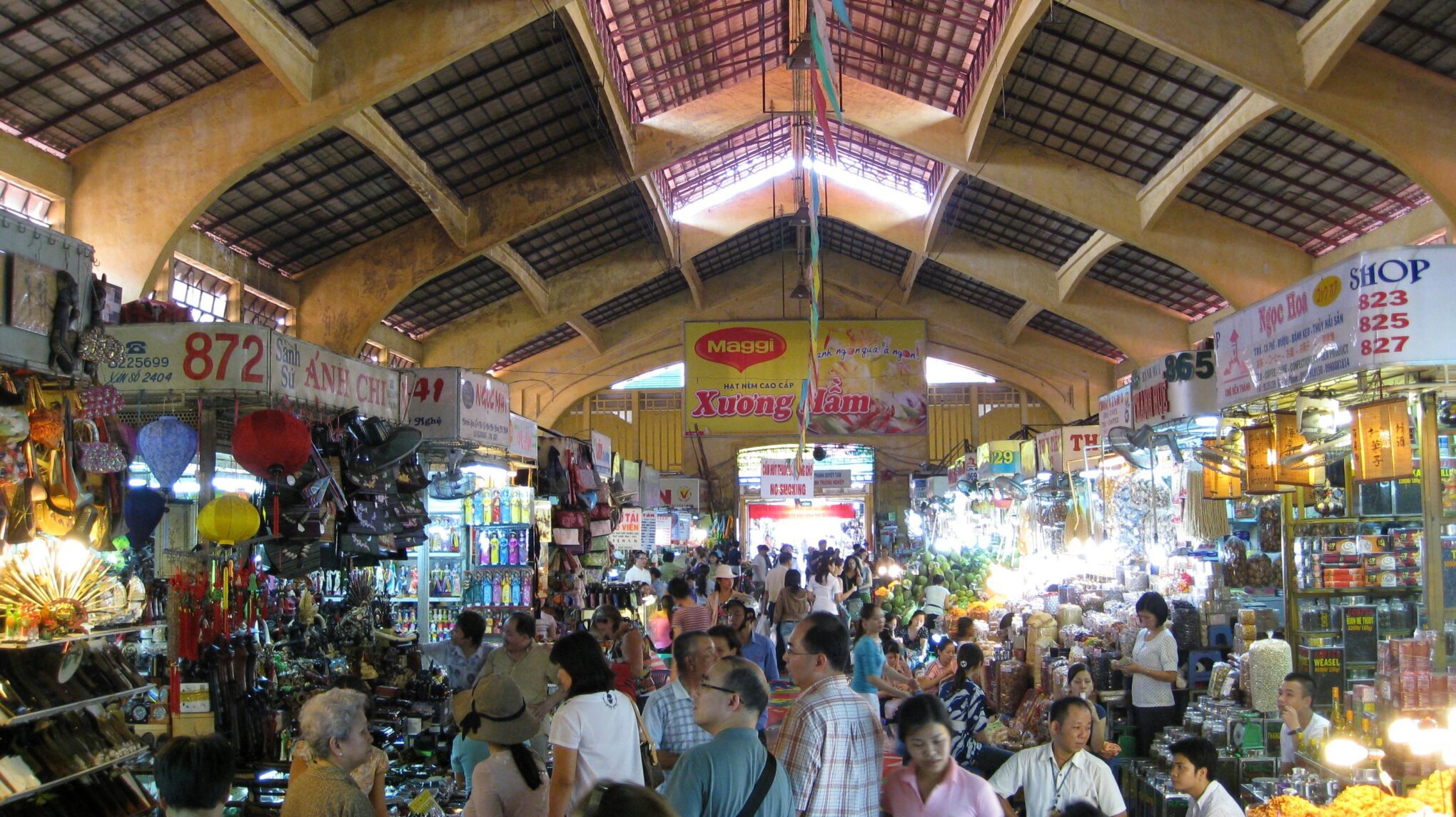Along the business center of the country, Ho Chi Minh City is today the hub around which Vietnam’s “socialist-oriented market economy” revolves. The oxymoronic nature of that phrase is symbolically demonstrated in the ideological war playing out on billboards, signs, and banners here. In busy shopping areas, the golden hammer-and-sickle insignia of the Communist Party competes with the golden arches of McDonald’s for the public’s attention. It’s Marx versus the Big Mac. Here’s a report, for Different Truths.
On the bustling streets of Ho Chi Minh City, for at least a moment, it’s possible to forget that this was once the center of a war zone. Just over fifty years ago, on January 30, 1968, the grounds of the American embassy in Saigon (as this city was then known) were captured by guerrillas of the National Liberation Front (NLF). They managed to hold on for six hours before U.S. paratroopers retook the compound, leaving the area littered with the bodies of NLF fighters. Similar scenes were repeated all over the city and up and down the country.
The surprise strike by the NLF (or Viet Cong) left the U.S. and South Vietnamese militaries stunned. It was one component of a larger wave of attacks launched in conjunction with the Lunar New Year holiday, or Tet, that stretched through much of 1968. Up to that point, few would have believed that Communist forces had the strength to launch such a campaign.
Hoping to inflict a blow to the South’s military capacity and break America’s will to continue fighting, NLF and North Vietnamese leaders instructed their fighters to “crack the sky and shake the earth.” Like the attack on the embassy, however, the entire offensive was a disaster, at least from a military perspective. The overwhelming firepower and technological advantages of the U.S. military and the troops of the Saigon-based South Vietnamese dictatorship pushed back the NLF and inflicted heavy losses on liberation forces.
But from a propaganda and political standpoint, the Tet Offensive was a resounding success, proving both the unpopularity of the U.S.-backed rulers in the South as well as undermining U.S. government claims of its impending victory. That the NLF was able to deploy a sizable guerrilla force throughout South Vietnam for an offensive of this size could only have been possible with the active support of civilians on the ground; this was no outside invading army. The grassroots base of the regime of General Nguyen Van Thieu—the South’s dictator-president—was so thin by this point that the Viet Cong seemed able to strike anywhere at any time. Desertions from his army were soaring.
Back in the U.S., the rosy picture of the war that the Johnson administration had been painting was exposed as nothing but fantasy. Headlines screaming, “Viet Cong Invade U.S. Embassy” were at odds with claims that the enemy was on the verge of capitulation.
Expressing emerging mainstream opinion among the U.S. public, CBS news anchor Walter Cronkite said of Tet: “It seems now more certain than ever that the bloody experience of Vietnam is to end in a stalemate. To say that we are closer to victory today is to believe, in the face of the evidence, the optimists who have been wrong in the past.”
By the end of March 1968, President Johnson ordered a halt to the aerial bombardment of Hanoi and other areas of North Vietnam. Nixon would later come along and escalate the campaign once more, but after Tet, there would be no rallying the American people to war again. The tide had turned in Vietnam.
The conflict in Southeast Asia—Cambodia and Laos were also on the receiving end of U.S. bombs—would not end for another seven years, until April 1975. In retrospect, though, the die was cast after the Tet Offensive, the eventual outcome quite clear. With Johnson’s decision to end the bombing campaign, Thieu knew his days were numbered. The Americans would surely pull out eventually, and Vietnam would be reunified. Abandoned by his own people and deserted by his U.S. ally, his government had no hope of surviving.
The legacy of the war is still acutely felt on the outskirts of Ho Chi Minh City as well, where some of the most intense fightings of the war took place. At Cu Chi, the tunnel network that enabled NLF fighters to evade U.S. forces (and the French before them) and strike, quite literally, from underground are now open to exploration. Climbing down inside the dark, cramped passageways dozens of feet below the surface for just a few minutes can make even the least claustrophobic person start to feel trapped. Spending days or weeks down there with dozens of other people while B-52 bombers pound you from above is unimaginable.
Even aboveground, signs of the past are still easy to find. There are bomb craters, of course, but also vast stretches of young trees—row after row planted in an attempt to replace the vegetation poisoned and killed by America’s campaign of chemical warfare.
But besides the living memorial to the ravages of war, there is another Vietnam on display these days: a developing society striving for modernity and prosperity. The Vietnam of 2018 is a country searching for new ways to pursue its long-sought goals of socialism and sovereignty in a world dominated by neoliberal capitalism.
Along the business center of the country, Ho Chi Minh City is today the hub around which Vietnam’s “socialist-oriented market economy” revolves. The oxymoronic nature of that phrase is symbolically demonstrated in the ideological war playing out on billboards, signs, and banners here. In busy shopping areas, the golden hammer-and-sickle insignia of the Communist Party competes with the golden arches of McDonald’s for the public’s attention. It’s Marx versus the Big Mac.
The reform process, whereby Vietnam sought to shift away from the centrally planned model rooted in Soviet experience, kicked off in the mid-1980s. In just over thirty years, statistics tell a story of success, but also of ongoing risk.
The Vietnamese economy combines private, social, cooperative, and state ownership forms and has the declared aim of developing the country’s productive forces to a high level while preparing the way for a future transition to a socialist economy.
Economic allocation and production decisions are largely determined by market conditions, but major public investment priorities are set by the government, and the strategic sectors of the economy remain under state guidance. This mixed approach shares characteristics with the socialist market economy model followed by China since 1978 and has produced remarkable achievements for Vietnam.
Since 1986, the extreme poverty rate in the country has dropped from more than 50 percent of the population to only three percent today. In human terms, this means more than twenty million people have been lifted out of poverty. Per capita incomes, meanwhile, have soared from only $100 USD to over $2,000 USD. This has pushed the country from being one of the world’s poorest to the lower middle income ranks internationally.
Going from battleground to economic hub in less than a lifetime, Ho Chi Minh City’s development has set the pace for Vietnam as a whole. The war-torn capital of a despised dictatorship only half-a-century ago is now the economic powerhouse for a country on the move toward prosperity. As the motor of Vietnam’s mixed economy experiment, this is where at least one chapter of international socialism’s future is being written. It’s certainly a place to watch closely in years to come.
C.J. Atkins
The writer is the managing editor at People’s World
©IPA Service
Photo from the Internet
#HoChiMinhCity #Vietnam #NationalLiberationFront #China #DifferentTruths






 By
By
